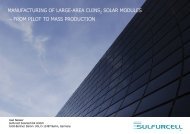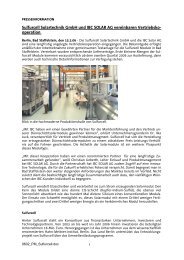ContaCt - Soltecture GmbH
ContaCt - Soltecture GmbH
ContaCt - Soltecture GmbH
You also want an ePaper? Increase the reach of your titles
YUMPU automatically turns print PDFs into web optimized ePapers that Google loves.
20 | 21 SULFURCELL MODULESTechnical backgroundEfficiency, energy yieldand profitabilityThe efficiency of a solar module reveals what proportionof the sunlight is converted into electrical power and whatelectrical power can be gained from a certain surfacearea. Solar modules are priced according to their output(measured in watts [W]). With regard to their efficiency,solar power systems only differ from one other in termsof the surface area that a solar installation with a certainoutput covers. Modules with a lower efficiency are usuallycheaper per watt than those with a higher efficiency.Hence, if there is enough space or if the investment sumhas to be kept low, low-cost solar modules with a lowefficiency should be used. However, if space is limitedand the output has to be maximized, a higher efficiencyis required and the price per watt will be higher too. Thus,higher efficiency often means lower profitability and agreater investment, but is more compact. So the efficiencylevel is just one of many quality criteria, but does notindicate the price/performance ratio.In 2008 Sulfurcell sold solar modules which had anefficiency of up to 7.5%, and higher efficiency rates areexpected in 2009 and 2010. The space needed for aSulfurcell installation is about two thirds more than for atypical polycrystalline silicon solar module. But Sulfurcell’scustomers know that Sulfurcell makes modules that aremuch more cost-effective than crystalline silicon productsof a comparable quality per watt of electrical output.In terms of the surface area of a roof, the savings factoris even greater: in this regard the Sulfurcell installationis up to 50% more cost-effective than an installation withsilicon modules. So if a roof is to be completely coveredwith solar modules, Sulfurcell modules lower the investmentand the loans required considerably.The annual energy yield – measured in kilowatt-hours peryear (kWh/a) – is not determined solely by the efficiency,for this depends on the illumination conditions and thee Sulfurcell’s solar modules are more “tolerant” of heatthan crystalline silicon modules and are therefore particularlysuitable for southern latitudes.r The monthly appraisal of the energy yields provesthe consistent performance of Sulfurcell modules andtheir strong performance in warm summer months.e1.2 kW1.1 kW1 kWActual output of 1 kWp solar power systems(with perpendicular sunlight, AM 1.5, 1 000 W/m 2 )t The energy yield from Sulfurcell’s modules is just asstable and as high as for polycrystalline silicon modules.In contrast to amorphous silicon, the capacity of Sulfurcellmodules does not decrease in the second operating year.u The warmer the place, the greater the benefits ofSulfurcell modules. In Greece, a 5% greater yield has beenmeasured compared to crystalline silicon modules.0.9 kW0.8 kW0.7 kW0.6 kWPolycrystalline siliconSulfurcell modules0°C 10°C 20°C 30°C 40°C 50°C 60°C 70°C 80°CModule operating temperature









